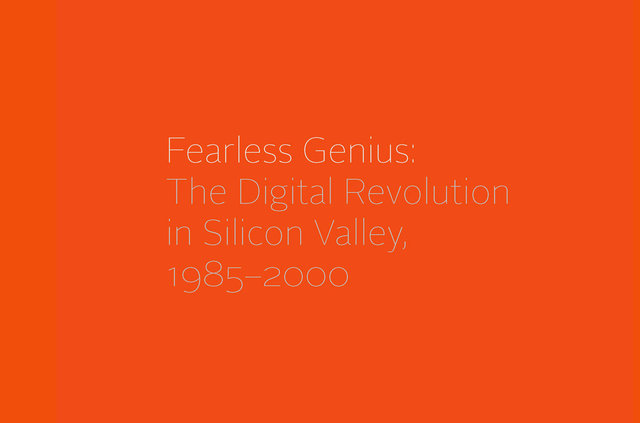Moscow Photobiennale
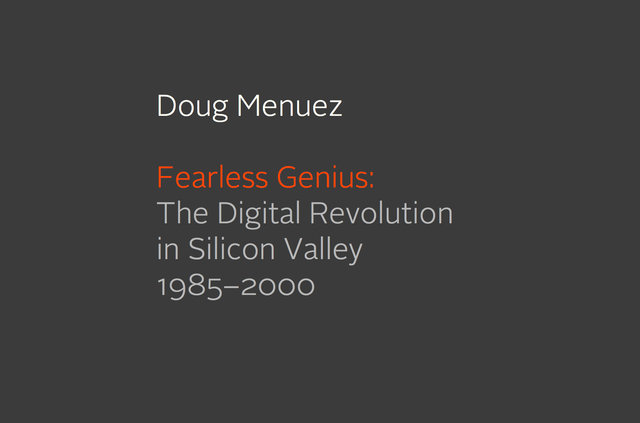
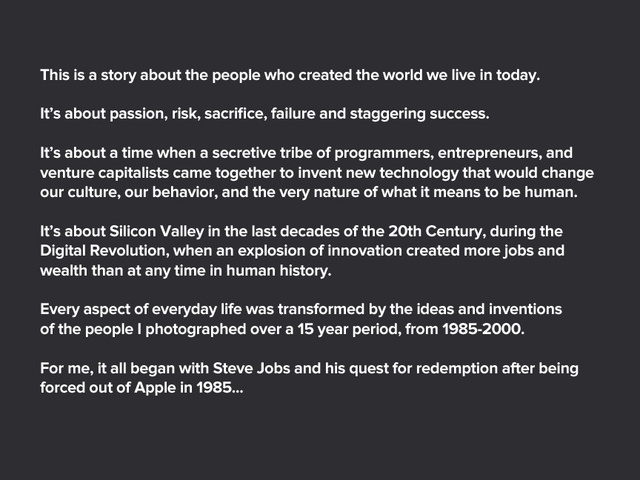
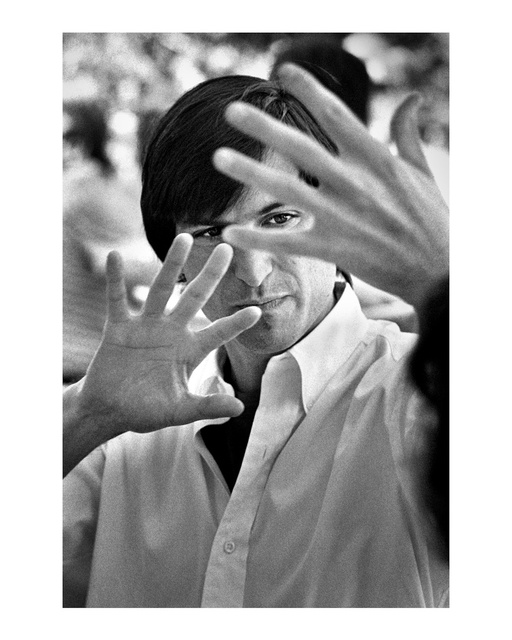
Steve Jobs Explaining Ten Year Technology Development Cycles. Sonoma, California, 1986. Steve Jobs shares with his team what he believes about how technology evolves in ten-year wave cycles. Steve hoped to ride the next wave by putting the power of a refrigerator-sized mainframe computer into a one-foot cube at a price affordable to Universities. Thus NeXT Computer began as Steve’s quest for redemption after being fired from Apple in a humiliating boardroom coup orchestrated by his hand picked CEO John Sculley. He gathered the best and brightest around him and began a classic start-up with his own seed money. Every few months, Steve and the fledgling company would travel to a retreat in the country with their families to grapple with myriad technical issues and make plans. Most industry pundits believed it would be a huge success. Instead, it was the start of over a decade of struggle for Steve.
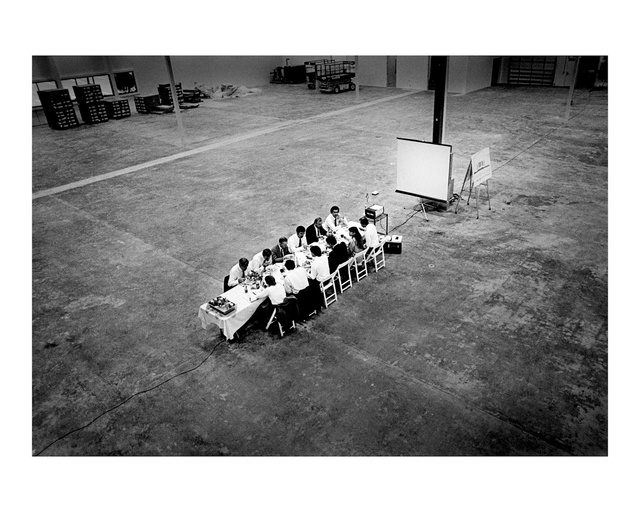
The Day Ross Perot Gave Steve Jobs Twenty Million Dollars. Fremont, California, 1987. Ross Perot invested over $20 million in Steve Jobs' new company NeXT after this lunch pitch with the NeXT Board of Directors on the site of the future NeXT factory. Even then, Steve was a consummate showman who understood the power of compelling settings. Instead of the traditional boardroom meeting, Steve chose to bring a formal lunch into the empty warehouse where he intended to build the world's most advanced robotic assembly line. To invent cool new technology required investors like Perot and good storytelling was part of the game. Fremont, California. 1987.
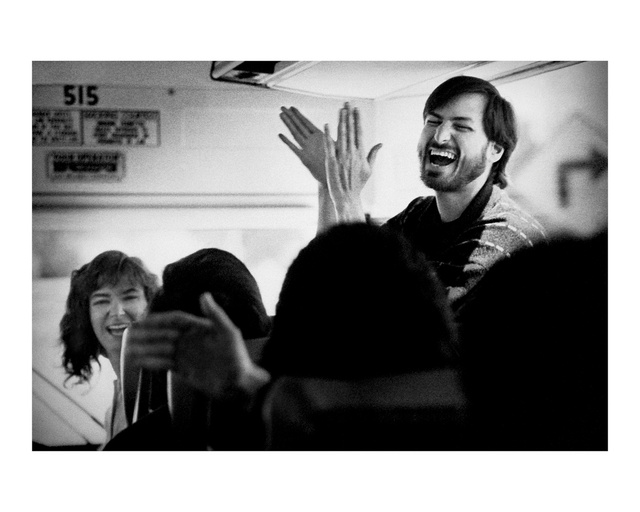
Steve Jobs Returning from an Employee Picnic. Fremont, California, 1987. Although Steve could be extremely rude, critical, and even vindictive, he also was incredibly joyful most of the time, with an infectious grin and energy that was irresistible. Still, I did not observe too many of the unrestrained moments of hilarity as shown here, while Steve was riding an old rented school bus with the company employees back from a tour of the empty warehouse where they intended to build the NeXT computer factory.
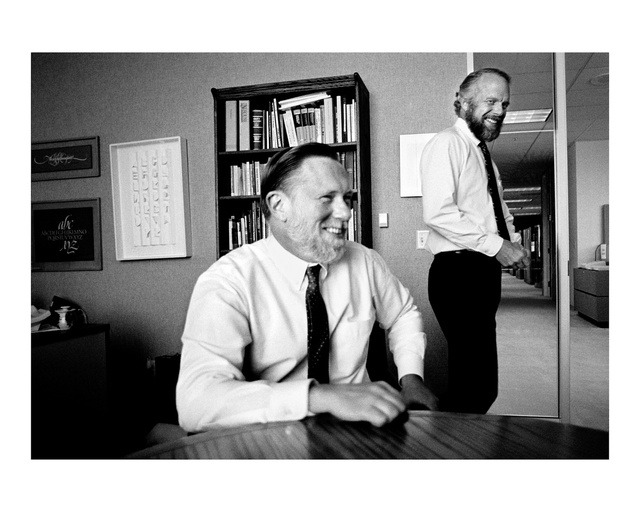
The Founders of Adobe Systems Preparing to Release Photoshop. Mountain View, California, 1988. John Warnock and Chuck Geshke, seated at left, confidently ready the launch of Photoshop, another landmark program they created that would utterly transform photography and the graphic arts. The pair left Xerox Parc to found Adobe in 1982. After thousands of hours of coding, they created PostScript, the software that allows computers to speak to printers, thus completing the biggest advance in printing since Guttenberg invented movable type in 1436. Their original business plan did not include licensing this software, however. Steve Jobs, in an early 80’s visit, convinced the founders to license the software to Apple for the Macintosh to use with the new LaserWriter. Steve also bought 19 percent of the company at the time, and paid a license fee in advance, making Adobe the first company in the history of Silicon Valley to become profitable its first year. No company since has equaled this feat.
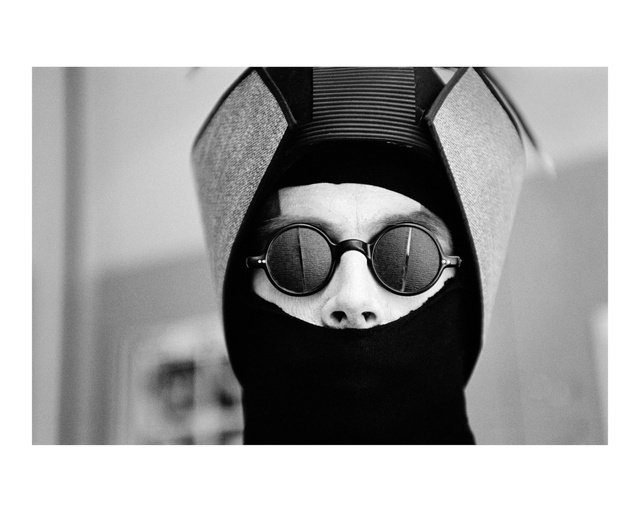
Portrait of Russell Brown in Costume. Mountain View, California, 1989. In a public defense of the early Photoshop, Russell Brown pointedly said that software is just a simple tool, like a hammer. You can use it to build a house or tear one down. Many photographers and graphic designers resisted digital technology as people normally resist change. Photoshop was a truly disruptive digital technology that hastened the death of film. But it was not a sure thing. More than anyone, Russell Brown deserves credit for winning over the creative community with his Photoshop classes and lectures.
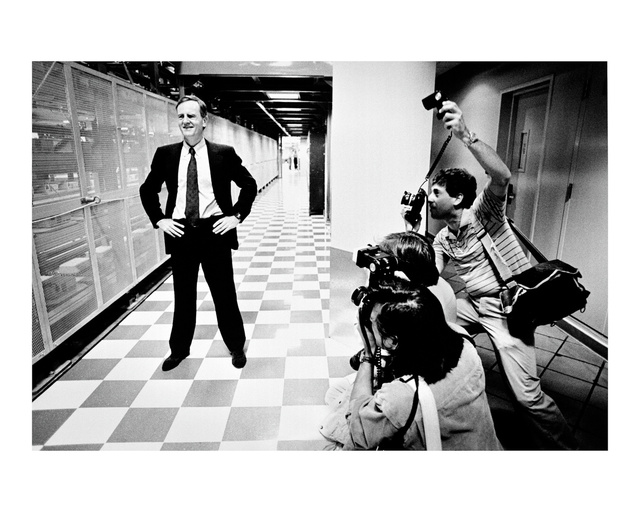
John Sculley Masters His Shyness To Meet The Press. Fremont, California, 1990. Apple CEO John Sculley overcame severe shyness and stuttering to become an excellent public speaker, able to easily greet the press at an Apple factory in Fremont. John was convinced by Steve Jobs to leave Pepsi and join Apple in 1983. Steve challenged John, asking if he wanted to sell sugar water for the rest of his life or change the world? Ultimately, Steve was pushed out, and John grew Apple from $800 million to $8 billion a year in revenue, a tremendous run. But he was sometimes criticized in the Valley as the man who fired Steve and not a technologist. That may have partly driven his decision to support the Newton PDA, a new product being developed inside Apple. At the height of his power, in February of 1993, he sat next to Hillary Clinton on national television to watch President Bill Clinton’s first State of the Union address. Even then John knew that despite outward appearances, Apple was in trouble, unable to rewrite the Mac operating system and innovate. Its market share was dropping fast as Windows grew, there was sales trouble in Europe and his bid to save Apple with the Newton device seemed too late. John had been thinking of leaving Apple, but a few months later he was gone, ousted from Apple in another boardroom coup.
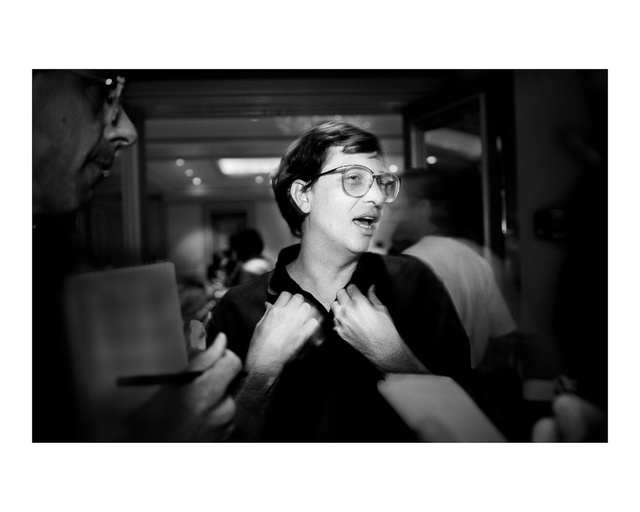
Bill Gates Says No One Should Ever Pay More Than Fifty Dollars For A Photograph. Laguna Niguel, California, 1992. Microsoft CEO Bill Gates discusses cheap content for the masses and debates with reporters about the long delayed “vaporware” upgrade to Windows at the Agenda ‘92 Conference. The conference was hosted by the irreverent pundit Stuart Alsop, who showed Gates no mercy. Later that year, at the influential TED Conference, Bill repeated his idea about the cost of photography, saying, “No one should ever pay more than fifty bucks for a photograph.” He was completing construction on a massive house in Seattle that would feature a screen that he wanted to display a continuously changing slide show. This led to the idea of forming a stock photography business that was originally called Continuum. After their first contract was excoriated in the photography trade press for its aggressive rights grab, the name changed to Corbis.
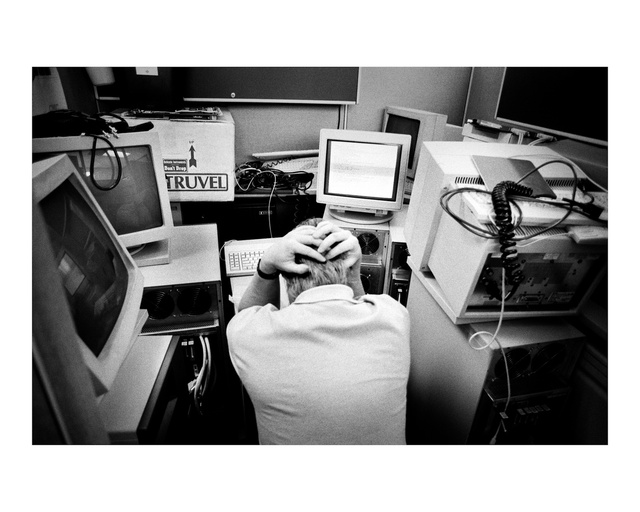
Frustration. Sun Microsystems, Santa Clara, California, 1992. Sun was the fastest tech company to reach a billion dollars in revenue. With the massive success came increasing competitive pressure and growing pains. The company grew to over 15,000 employees worldwide in a few short years, forcing whole divisions to quickly move offices. This engineer is trying to grab a few moments of work during a move of a group of cubicles.
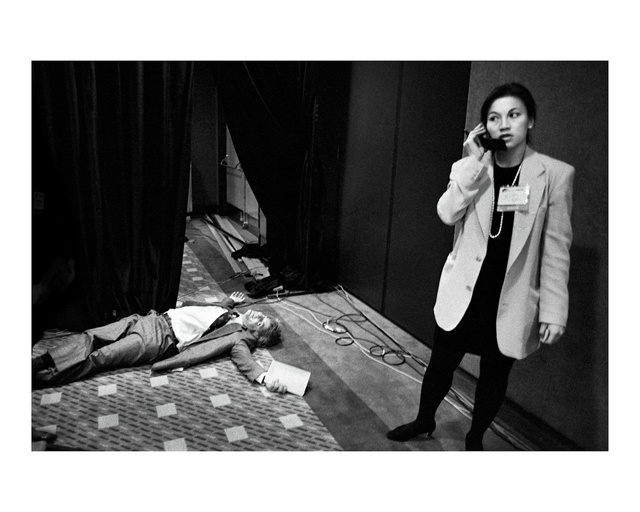
Preparations for the Demonstration Are Not Going Well. Las Vegas, 1992. Unfortunately, while preparing a demonstration of the Newton for the national press in Las Vegas, the device crashed, causing event organizer Michael Witlin to hit the floor and Tricia Chan to call engineers for help. Apple’s handheld Personal Digital Assistant promised to solve the problem of organizing names, addresses, notes, and would also provide email. John Sculley had green lighted a rebel unit within Apple with an impossible deadline to combine several untested new technologies into a new product for a market that did not yet exist. Sculley hoped the Newton would vindicate him as a true technology leader. It used a revolutionary form of handwriting recognition software based on natural gestures. Actually, Apple worked for years on this but could not solve the tricky challenge. Then, by chance, one night in 1987 in Moscow, an Apple board member answered a frantic knock at his hotel door. A Russian engineer nervously handed him a disc containing the breakthrough handwriting recognition software Apple desperately needed and quickly walked away. His software was incorporated in the Newton. It worked great for me, but Apple shipped the Newton before it was finished and it did not quite work well enough for most people. This led to rare public ridicule and criticism of Apple.
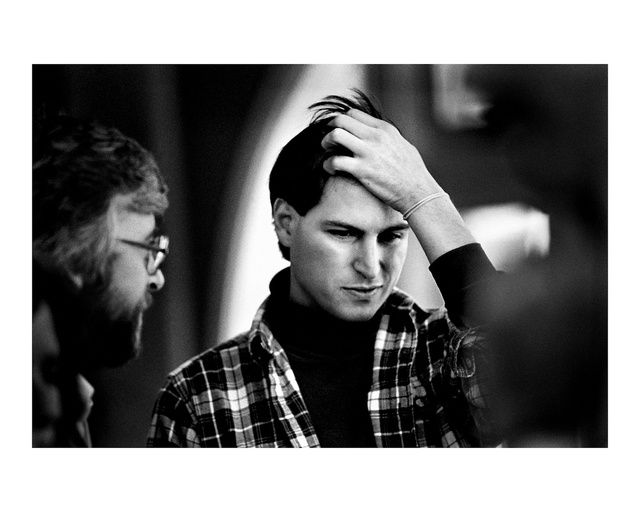
Steve Jobs Considers a Response. Palo Alto, California, 1986. NeXT Computer Design Director Eddie Lee said that Steve had a way of “smiling shit at you” when he was getting mad. When Steve was upset, his head would go down and he’d make this sort of uncomfortable half-smile and you knew you were about to get crushed. Here, Steve displays the beginning of this warning half-smile during a conversation with one of the original Macintosh engineers. Eddie also said if Steve approached with his head up and smiling, you were golden, and all was right with the world.
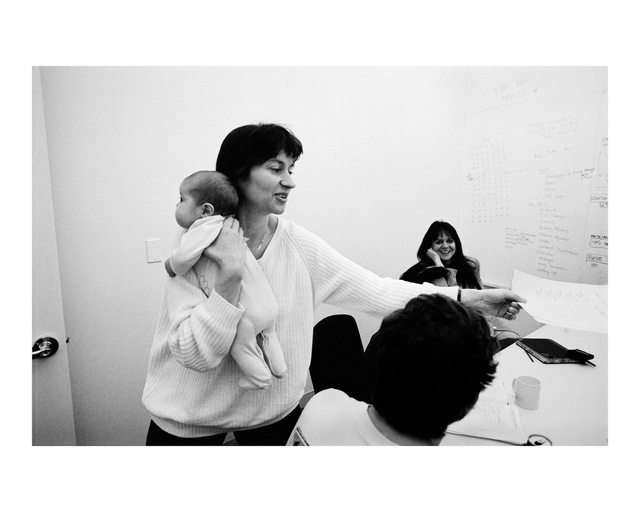
The Newton War Room at Apple Computer. Cupertino, California, 1993. Apple programmer Sarah Clark delivers a message to the Newton War Room. Sarah kept her baby with her at work, almost never leaving the building for two years as the team rushed to finish the software. She pulled curtains over the glass of her office so colleagues knew when it was naptime or if she was breastfeeding.
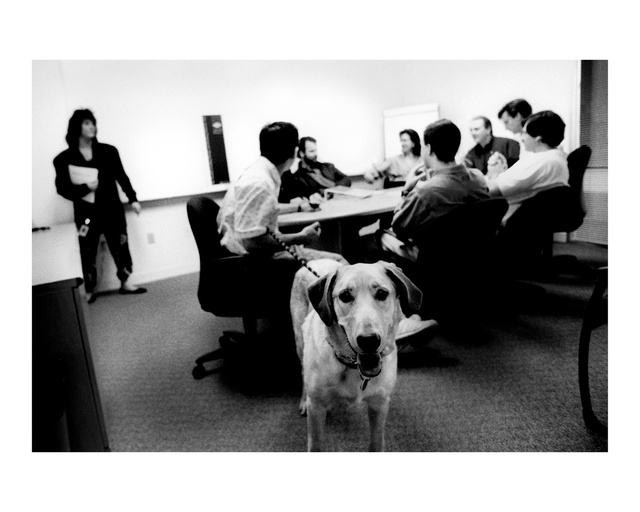
A Dog of Autodesk. San Rafael, California, 1995. Autodesk was one of the first tech companies to encourage and allow employees to bring pets to work as the culture of the workplace became more attuned to employees needs. Studies show interacting with pets lowers heart rates and stress at home and at work.
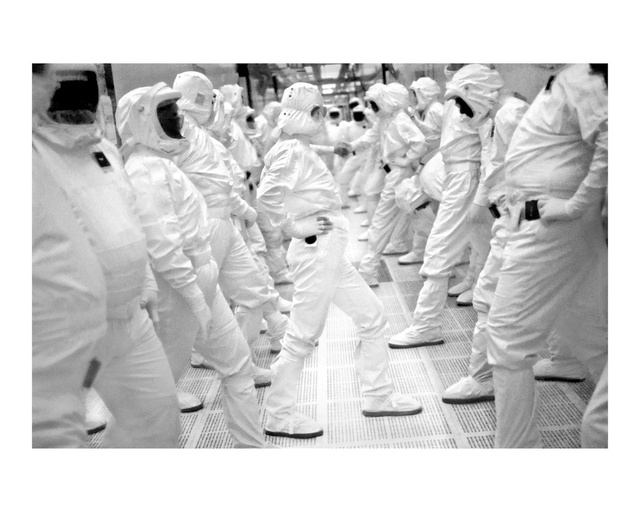
Exercise Break at Intel Fab 11X. Rio Rancho, New Mexico, 1998. Workers inside Intel’s largest chip fabrication plant exercise and stretch as part of their normal workday break time. They produce 5 chips a second, 24 hours a day. Many of the workers are from the nearby Pueblo tribe of Native Americans, who maintain their traditions when not working with new technology. After work in good weather, many tend their corn and bean fields with their families before dinner. An industry powerhouse, Intel chips run most of the PC's in the world. They helped Microsoft Windows become the dominant operating system. Founded by industry legends Gordon Moore and Robert Noyce, with Andy Grove their first employee. Moore posited “Moore’s Law” which predicted the number of transistors placed on chips would double approximately every two years. Noyce is co-creator of the microchip that gave Silicon Valley its name and which fueled its growth. Although Steve Jobs hated Microsoft Windows and was unhappy about Intel's support of Microsoft, he acknowledged the Pentium chip as a true innovation and said it was "the coolest thing out there" when introduced. Shortly after Steve took back power at Apple, he switched Apple computers to Intel chips.
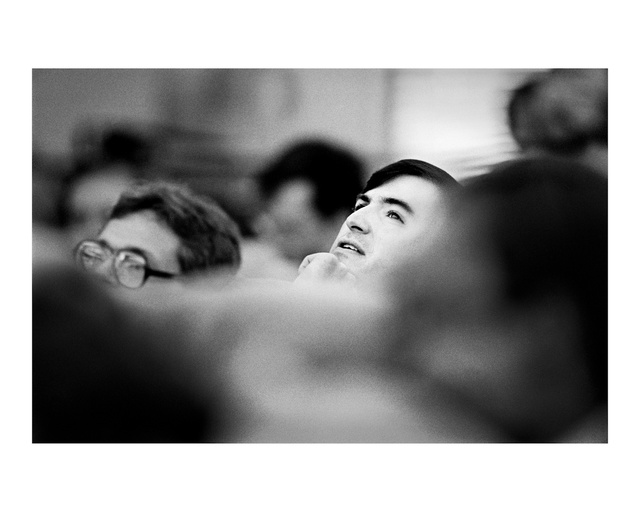
Steve Jobs Is Thinking. Santa Cruz, California, 1987. Steve had an artist’s intuitive mind with the ability to dream up new ways to combine existing technology to create something completely new. Here he is pondering a solution to a technical problem being discussed at a company offsite meeting. Another of the many attributes that set Steve Jobs apart was his refusal to take no for an answer. Conventional wisdom said that what Steve wanted to do was impossible. He surrounded himself with the most brilliant scientists available, smarter than he was. But he gathered them to change the world, nothing less and did not care what established science viewed as impossible. One was described as “spitting teeth” he was so angry with Steve for not listening to reality. But Steve created his own reality. He dragged his geniuses kicking and screaming toward the future, banging heads and making people crazy until they somehow raised up the miracle Steve demanded.
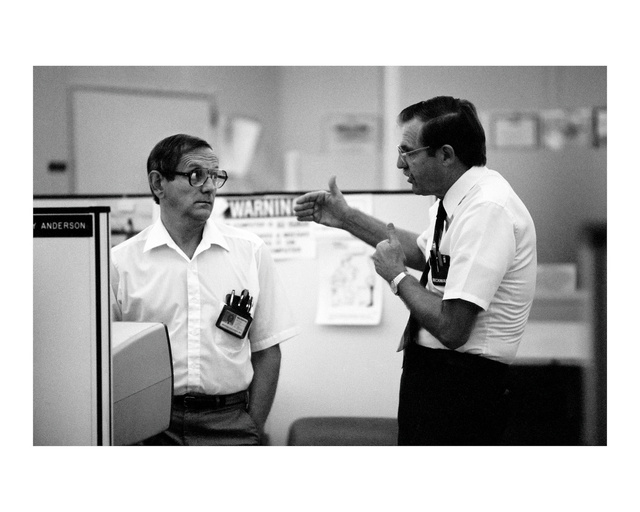
Engineers at Beckman Instruments. Fullerton, California, 1989. A pair of veteran engineers at Hewlett Packard’s then biggest rival, Beckman Instruments. With their pens in pocket protectors, and slide rules, these men present an image of classic nerds. They in fact represent the mathematic pioneers and heroes of World War II, the space-race technology and a generation of giants who built Silicon Valley. The Steve Jobs generation of hippie-geeks that followed brought a relaxed, rebellious attitude along with new ideas to disrupt the status quo. They tossed the pocket protectors, ties, rules, and regulations, turning the naturally cautious engineering culture upside down. Today there are not enough trained engineers to fill the jobs in Silicon Valley.
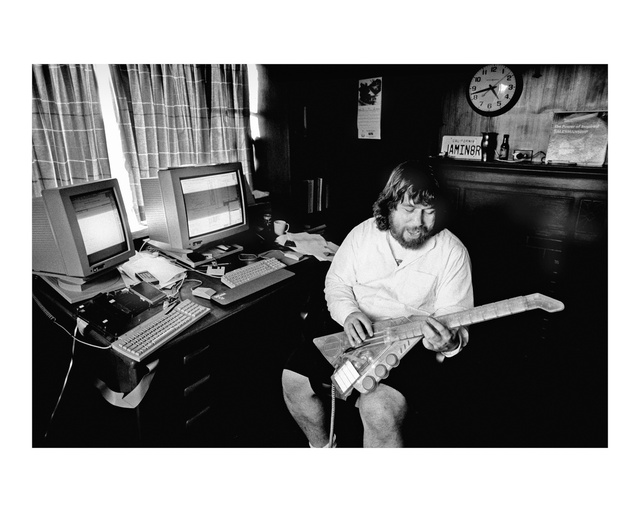
Steve Capps Playing The Jaminator. San Carlos, California, 1993. Steve Capps, a modest, unsung hero in the Valley, is co-designer of the Macintosh Finder and helped develop much of the graphical user interface that all interface innovation over the past few decades is based on. In this image, he’s playing The Jaminator, a digital guitar he invented that lets you play your favorite guitar solos to various hit rock songs, while working at home on the Newton software. Working twenty-hour days led Steve to start working from home, where I would sometimes arrive to find him asleep on a mattress on his front porch, often in the blazing morning sun. He said he wanted the Newton to be so intuitive that his mother could use it. Years later, Steve Jobs returned to Apple and killed the Newton, but many of the core Newton ideas live on in the iPhone today. Capps later quit Apple to work for their former sworn enemy, Microsoft.
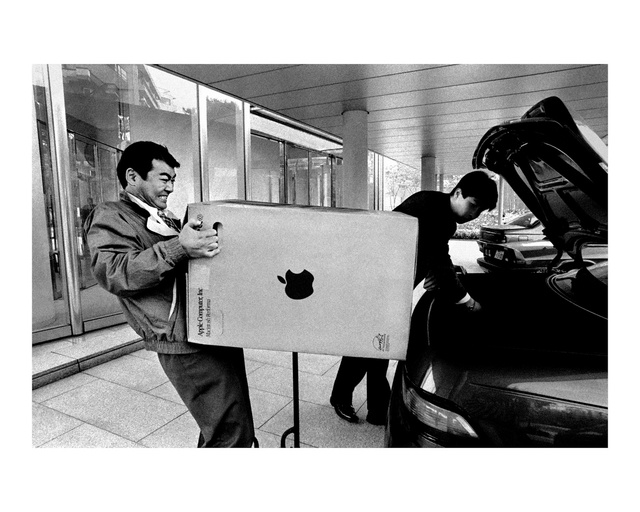
Apple Store. Tokyo, 1995. An Apple salesman helpfully attempts to load a new Macintosh into a customer’s car. Macintosh quickly gained a small but loyal following of fans worldwide, but especially in Japan.
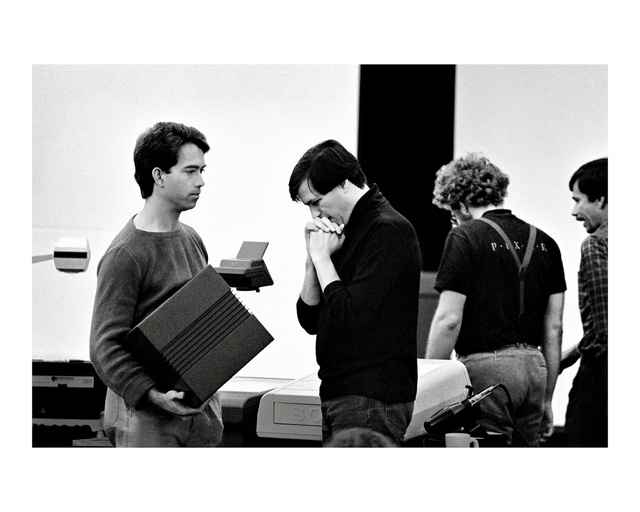
Steve Jobs Views the NeXT Computer Case Prototype. Santa Cruz, California, 1987. Steve Jobs is agonizing over the surface texture of the anodized cast magnesium cube for the NeXT computer. Magnesium is lightweight and strong, but the complications of manufacturing the cube to Steve’s standards were adding quickly to the cost. Most people are aware of Steve’s perfectionism and harsh rebukes to those he disagreed with. Part of his process was based on his need to trust. Innovation is incredibly difficult, not only building the product, but also bringing it to market as most products fail. Steve could be ruthless because he understood the stakes and knew that every one of his thousands of decisions would add up to either failure or success depending on how many were correct. He had to believe that the person presenting a solution or option had thoroughly done their homework before he could gamble on their suggestion. That might mean twenty minutes of intense questioning, which could sometimes include shouting, until he was satisfied. Some employees felt he could be abusive, others didn't take it personally. Eddie Lee said "Steve was all about making the thing better. It wasn't personal." But everyone involved also believed it was worth the price to be part of a team that changed the world.
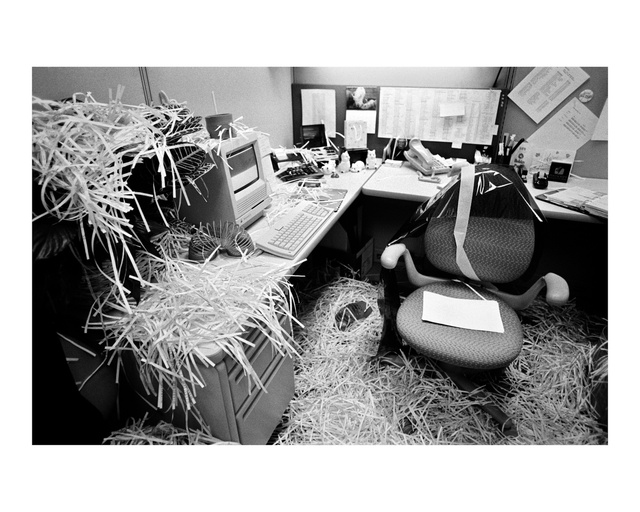
On Vacation. Adobe Systems, Mountain View, California, 1994. Don’t go on vacation is the subtext of this scene. As Silicon Valley companies evolved from kids in garages to global technology behemoths, they began to adopt standard corporate practices like granting health insurance and paid vacations. Adobe Systems was very well managed as judged by their balance sheet and the apparent happiness of their employees. Still, the hours were long and competition fierce, so vacations were often deferred or delayed. And when someone did go ahead and actually take the vacation days they earned, they might return to find their office had been redecorated.
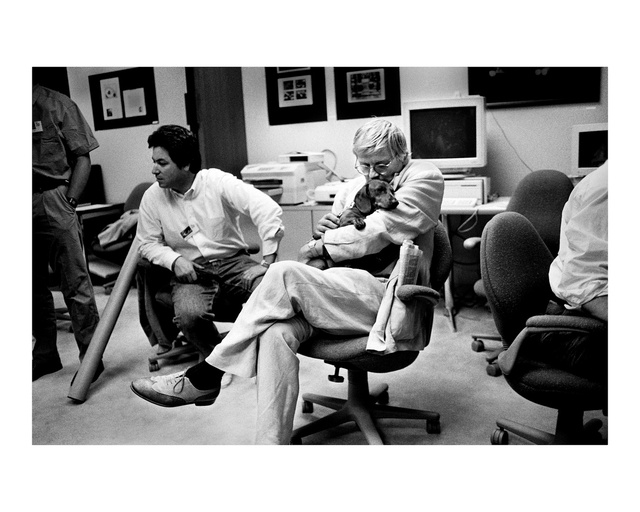
The Painter David Hockney Rests During a Photoshop Class. Mountain View, California, 1990. As digital technology grew more powerful, Silicon Valley resembled what Paris in the twenties must have been like. Artists arrived from all over the world, eager to experiment. Musicians like Peter Gabriel and Herbie Hancock were early adopters. George Lucas was a pioneer, as was Francis Coppola, and there were many others. The cultural ground was shifting with the avant-garde gathering to push new ideas into the culture. Here, British painter David Hockney, holding one of his beloved dachshunds, attends Russell Brown’s 1990 Adobe Photoshop Invitational, where he learned how to use the first release version of Photoshop.
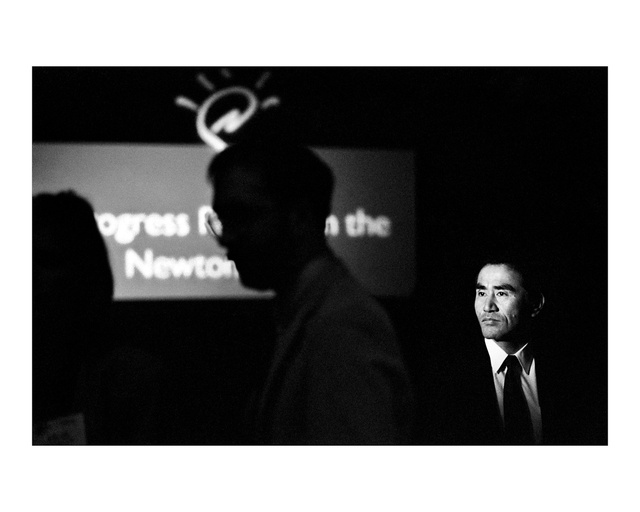
Akira Mitarai Has Agreed that Sharp will Build the Apple Newton. Las Vegas, 1993. Prior to speaking to the press at a Las Vegas technology conference about his company’s role in building the Apple Newton, Sharp Corporate Director, Akira Mitarai, is gathering his thoughts. Sharp was growing increasingly concerned about Apple’s failure to finish the Newton software on time. Ultimately, his concerns proved valid as Apple missed the deadline and asked Sharp to build 4,000 rush units for the product launch running beta software.
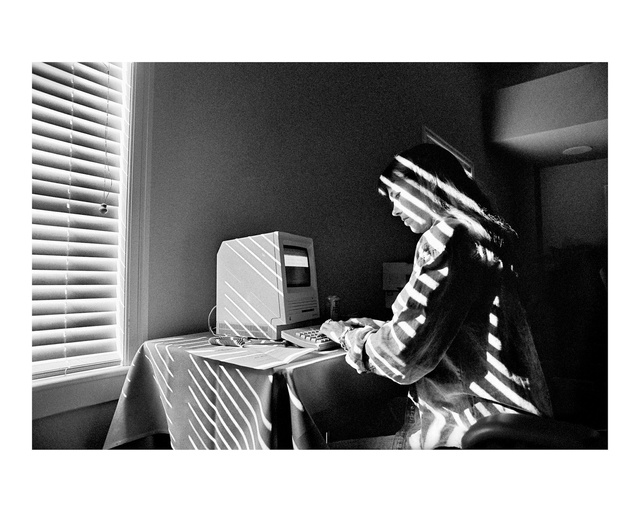
Sunlight, NeXT. Sonoma, California, 1986. At tech start-ups it was rare to get outside or even see the sun for days at a time. A young NeXT employee working on an early Macintosh at a company retreat focuses on the task at hand, closing the shades and ignoring the insistent sunlight.
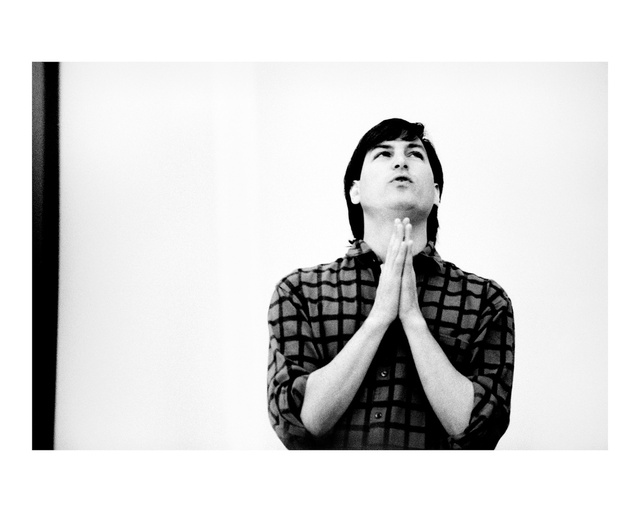
Steve Jobs Rallies the Troops. Redwood City, California, 1988. Steve gives a rousing pep talk to his employees shortly before the launch of NeXT Computer, while also indulging in a short rant about revenge on Apple and John Sculley. After three years of exhausting, almost super-human development with his small team, Steve Jobs’ redemption and return from the technology wilderness seemed at hand. It was not to be. The launch was a massive PR success, but his key partners in education felt betrayed by the NeXT workstation’s high price. The company slowly faded, with Steve closing the NeXT hardware division in 1993 in another painful, public failure. He’d almost run through all his money between NeXT and Pixar and was close to broke. His years of struggle extended for more than a decade. But the NeXT software was years ahead of its competition, and in 1996 Apple bought his operating system. He gained a seat on the board and soon was back running Apple. He began releasing one successful product after another while Pixar was producing back-to-back movie hits. The Pixar IPO made him a billionaire. Apple became the most valuable company in the world. After more than a decade of disappointment and failure, Steve Jobs made the greatest comeback in business history.
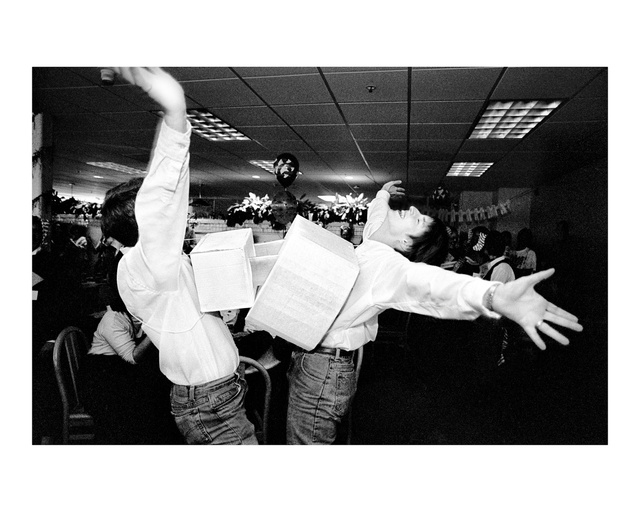
Geek Sex. Adobe Systems, Mountain View, California, 1991. A couple of Adobe employees who were real-life boyfriend and girlfriend act out a rudimentary, but technically appropriate, metaphor for sex at a Halloween party. Technology workers were notoriously socially inept and often shy, especially male engineers. Fantasy games and role-playing were very popular, and any opportunity to dress in costumes was welcomed. It was a lot like high school. They repeated the ritual all over the company to the delight of fellow workers.
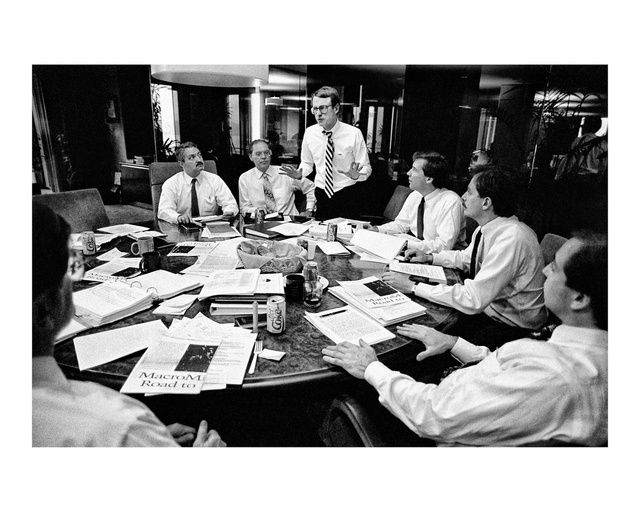
John Doerr and Partners Discuss the Future of the Internet. Palo Alto, California, 1994. John Doerr making a point during one of Kleiner Perkins Caulfield & Byers’ famous Monday Morning meetings where they reviewed potential companies they might invest in. Entrepreneurs would make their “elevator” pitch–about as much time as an elevator ride–and hope for the best. They were already seriously invested in several early internet companies and about to help launch Netscape which started a gold rush of dot coms. Kleiner Perkins remains a premier venture capital firm with a storied legacy. They invested and helped found an astounding string of successful companies such as Genentech, Compaq, Sun Microsystems, AOL, At Home, Amazon.com, and Netscape, among many others. Partners today include former Vice President Al Gore, General Colin Powell, William Randolph Hearst, III, and Bill Joy, co-founder of Sun Microsystems.
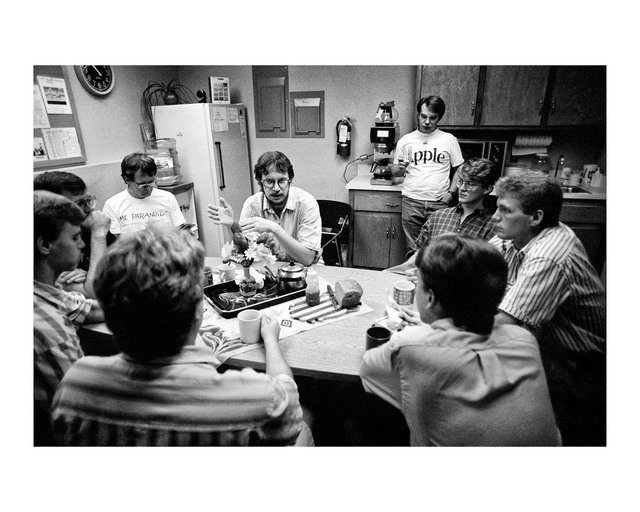
Apple Engineers at Breakfast. Cupertino, California, 1991. A tranquil morning meeting where Apple Newton team members appear rested, calm, bathed, and organized. A year or so later would find the team gripped in extreme chaos, exhausted and rushing to meet unrealistic deadlines, with one member dead, another hospitalized, and what proved to be unsolvable technical issues looming.
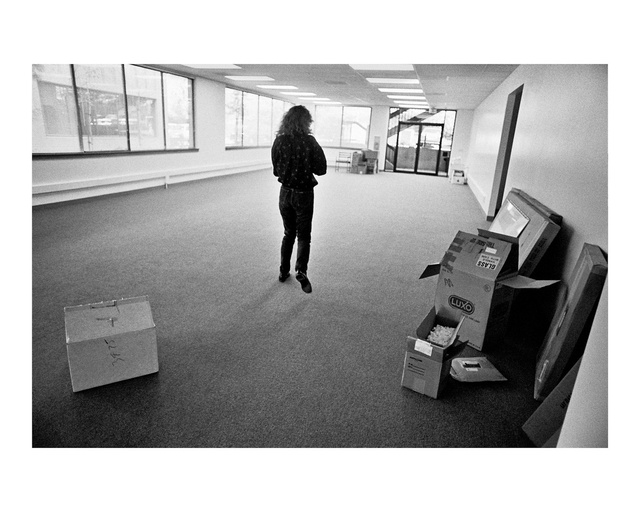
Susan Kare is Part of Your Daily Life. NeXT Computer, Palo Alto, California, 1986. Susan Kare designed the icons for the Macintosh, Windows and IBM’s OS2, among many other operating systems. Her work has impacted the daily lives of hundreds of millions of people around the world. Here she is walking through the new NeXT Computer offices in Palo Alto as they are adding employees and converting the empty space. She was part of the original Macintosh team at Apple where she designed the famous icons. Leaving Apple with Steve after his ouster, she became a co-founder and Creative Director at NeXT computer, where she oversaw design of its icons and logo, working with the legendary designer Paul Rand.
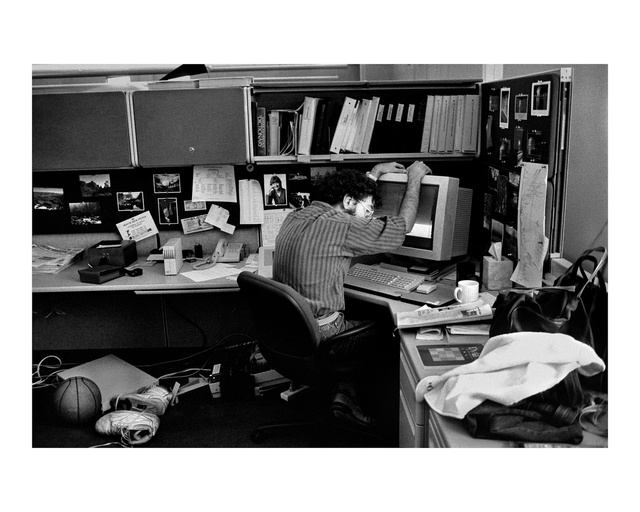
A Million Lines of Code. Cupertino, California, 1992. Programmer Peter Alley rests during the big push leading up to the announcement of the Apple Newton by John Sculley at the CES show in Chicago. Thirty programmers were writing a million lines of code with a deadline of one year and nothing was quite working yet. Shortly after this photograph was made, a decision was made by Gaston Bastiaens, a new executive brought in by John Sculley to rush the Newton to market, to switch to a new chip. Bastiaens gave the team an ultimatum to re-write the entire million lines of code and gave them another year to finish. A young programmer named Ko Isono went home, loaded a pistol, and shot himself in the heart.

Investors. Fairmont Hotel, San Francisco, California, 1992 The digital revolution could not have happened without experienced investors taking tremendous risks on the ideas and talent of young entrepreneurs. In 1975 the total investment in Silicon Valley, including all sources, was just 10 million dollars. By 2000, at the end of my project, it was over 100 billion dollars. At a high-tech investor conference in a San Francisco hotel, a bit North and a world away from the grungy engineer start-ups of Silicon Valley, venture capitalists are making deals. And friends.
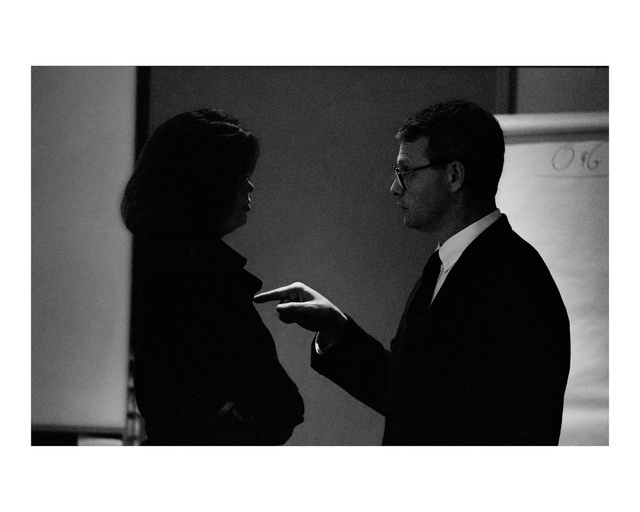
Private Conflict During an Investment Meeting. San Mateo, California, 1990. Despite all the advances of the women’s movement, Silicon Valley was a mainly white male dominated environment. During a break in a tense investment meeting, a manager aggressively makes his point during an “offline” private dispute with a female employee. Astonishing amounts of money were flowing into Silicon Valley from retirement and pension funds into investment funds like this one, flaring tempers and skewing judgment. In 1975, the total investment in the entire Silicon Valley totaled just $10 million. By the time of this photograph, it was approaching $10 billion and rising. By 2000, it was a staggering $112 billion. And then it all crashed.
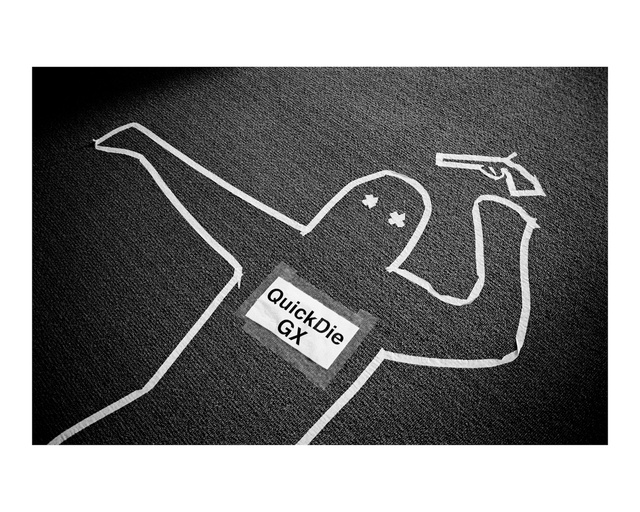
A Cry For Help at Apple Tech Support. Austin, Texas, 1996. Although the Macintosh aimed to be easy to use, as it evolved it became more complex and unwieldy. Users were frustrated and angry and took it out on tech support employees. At their center in Austin, one employee vented his frustration at Apple’s own buggy QuickDraw software with a graphic floor display.
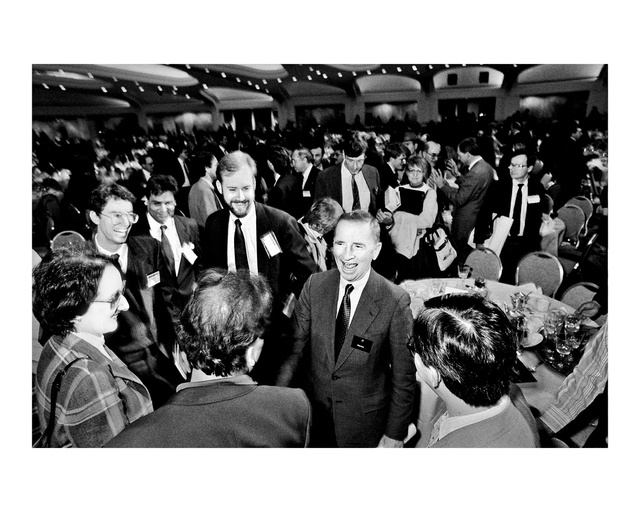
The End of the Beginning. Washington, DC, 1988. NeXT investor and board member Ross Perot, CEO Steve Jobs, and marketing executive Kathy Kilcoyne enjoying the afterglow of a successful series of days presenting the NeXT computer to their key market target at Educom ’88, a national conference on computing for higher education. This was just days after the San Francisco launch and Steve and his team were utterly spent. Having created a frenzy of media interest, the already intense pressure on everyone at NeXT was now an order of magnitude greater as they were still months away from releasing a finished product. Sales never really took off, and despite some bright spots the company slowly faded, with Steve closing the NeXT hardware division in 1993- a painful, public failure. He’d almost run through all his money between NeXT and Pixar and was close to broke. His years of struggle and disappointment extended for more than a decade before his stupendous comeback at Apple. Through it all Steve never gave up his belief in himself or his humanist vision for computers that could improve our world.
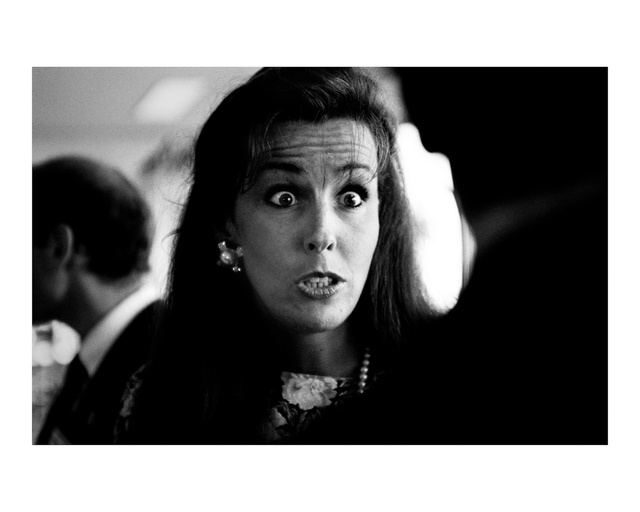
Anxiety is Sweeping the Room. Emeryville, California, 1991. Over the fifteen years that I documented the Valley, the competitive pressure to get new products to market was unrelenting and kept increasing every year. During a party to celebrate the company move and expansion, employees discuss an upcoming deadline for preparing a product demonstration at an industry trade show.
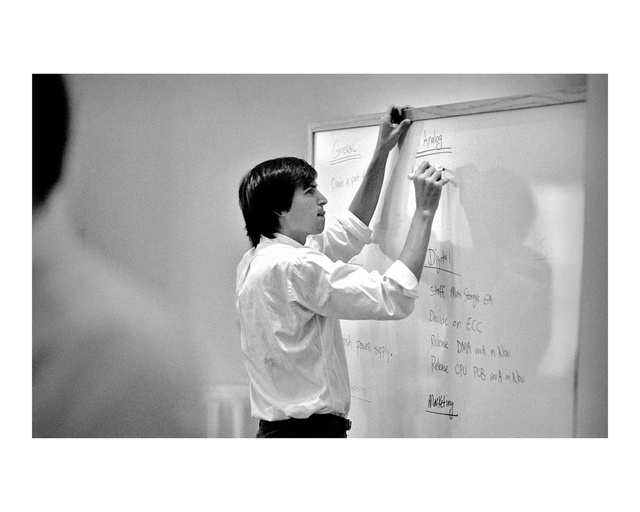
Steve Jobs Outlines the Digital Revolution. Sonoma, California, 1986. Steve Jobs lists the workflow ahead for his team at a company meeting at a Sonoma resort. He is outlining what remains to be converted from analog to digital. Indeed, everything in the world–photos, film, music– that was not already digital by now, would soon be, as the digital revolution expanded.
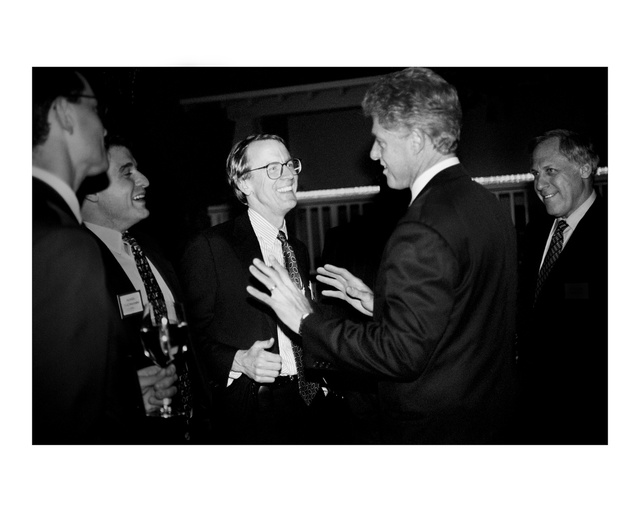
President Clinton is Really Smart. Mountain View, California, 1995. During his re-election campaign, President Bill Clinton attended a fundraiser thrown by the top CEO's of Silicon Valley. Venture Capitalist John Doerr helped organize the visit at the home of celebrated PR innovator Regis McKenna and is at center interacting with Clinton. During dinner, they peppered Clinton with hard questions related to complex technology, trade, and economic issues. Listening patiently, the President smoothly delivered a point-by-point rebuttal to each guest in turn, revealing a jaw-dropping breadth of knowledge about all the issues, even obscure aspects of encryption technology. Everyone pulled out their checkbooks and donated generously to the campaign.
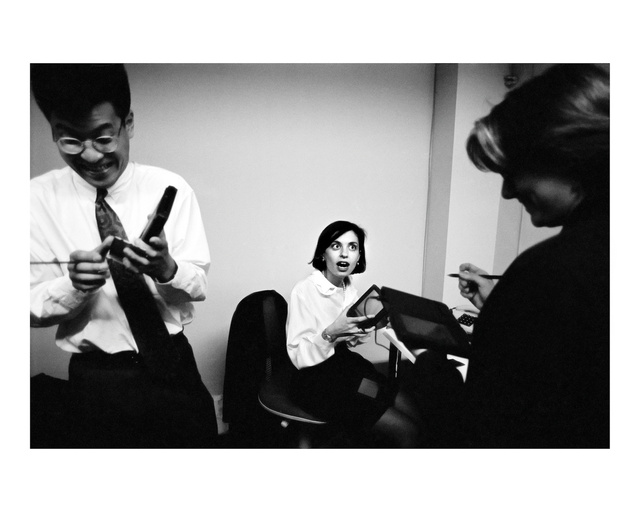
Imagine If You Will. Hanover, Germany, 1993. Backstage before a press briefing, Newton team members Michael Tchao, Nazila Alasti, and Susan Schuman discover many of the prototype Newtons they brought to demonstrate are dead. They can hear the hundreds of German journalists who’ve been waiting over an hour to see the promising new product as they drunkenly chant “Newton, Newton.” Tchao soon took the stage and began his speech describing the non-functioning Newton by suggesting, “Imagine if you will...”
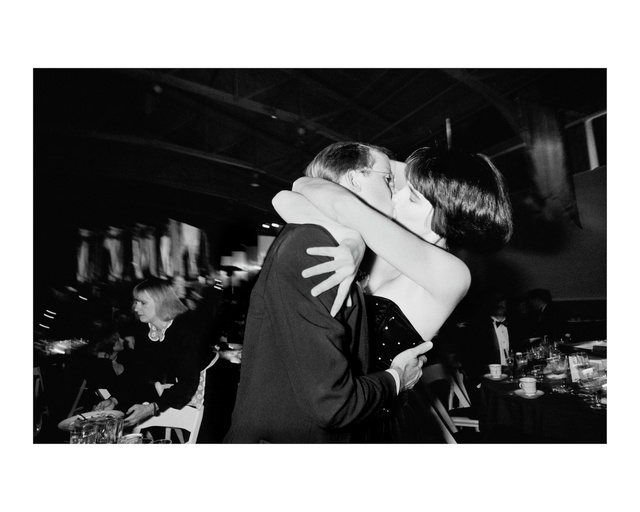
The Kiss. San Francisco, California, 1988. A couple of co-workers that were falling in love celebrating with abandon at the Adobe annual holiday party of 1988. They were married shortly after the party but divorced a few years later.
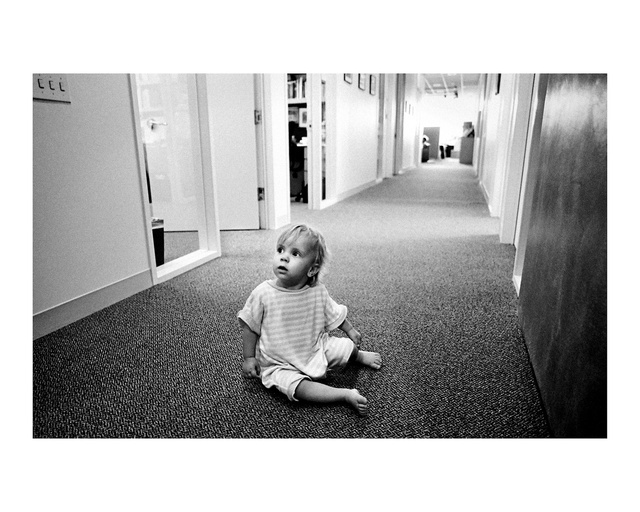
An Infant at Apple. Cupertino, California, 1993. As the Newton team worked even more hours, including almost every weekend, they began to bring wives, husbands, and children into the Apple offices. That way kids could see their parents in daylight hours. Today, Apple employees still work very long hours, particularly when new products are being readied for market.
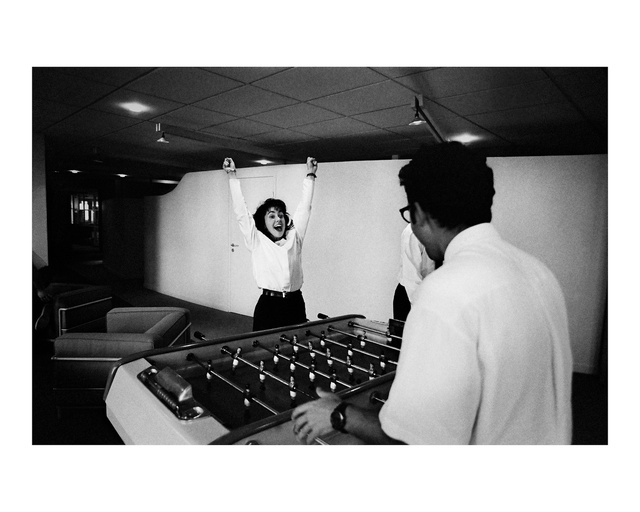
The Apple Newton Team in Paris. Paris, 1992. Product Marketing Specialist Joyce Gelbach beats James Joaquin, right, at Foosball during a break from a stressful daylong meeting with Apple Europe employees in Paris. They were on a world tour to drum up press interest in the Newton even though it was not going to be ready to ship for at least another year.
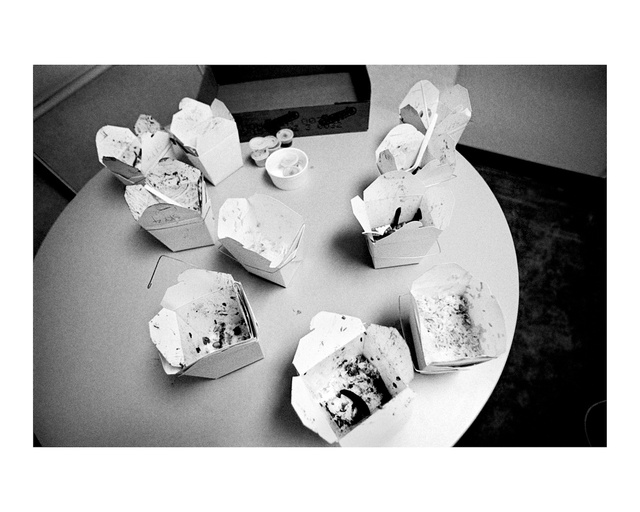
Evidence of an All Night Programming Session. NetObjects, Redwood City, California, 1997. Morning finds empty Chinese food cartons left by engineers working all night to finish an important version of the software, at the headquarters of NetObjects. Launching in 1996 with founders Samir Arora and Clement Mok, they were the first company to create software that allowed anybody to make their own web pages.
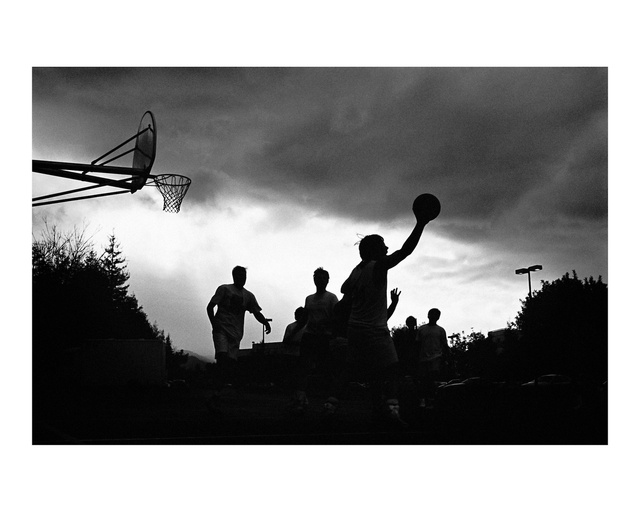
Basketball at Sunrise. Apple, Cupertino. California, 1992. After working all night coding, Apple Newton team programmers play basketball while the sun rises, before heading back to work. Today, leading tech companies provide indoor basketball courts, large gourmet cafeterias, daycare, healthcare, massage, dry cleaning, travel services and banking to their employees. What started as impromptu methods of humanizing a crushing work schedule has become institutionalized, although some argue that these perks merely keep people on campus working longer.
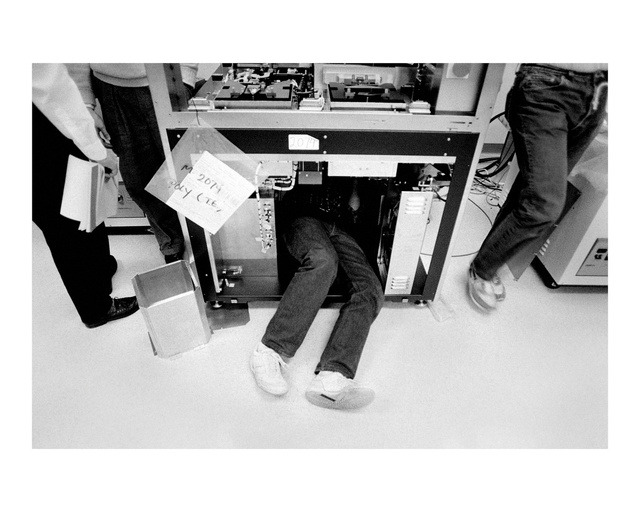
Workers at LAM. Silicon Valley, California, 1990. An engineer labors to solve an electrical connection problem in the assembly of a complicated chip-testing machine. LAM is part of a whole sub-industry that grew around testing computer chip manufacturing machinery.
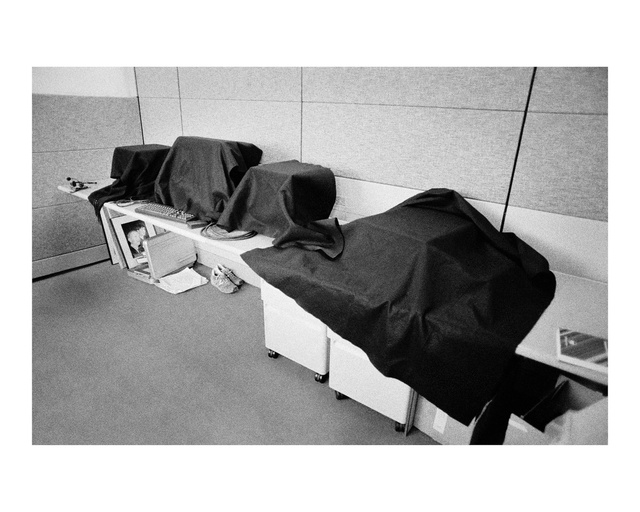
Loose Lips Sink Ships. Redwood City, California, 1988. Shortly before the official launch of the NeXT Computer, Steve had the completed prototype computer, screen, printer, and peripherals covered in black velvet. Tech companies were extremely competitive and secretive, to the point where precautions were taken even inside closed doors.
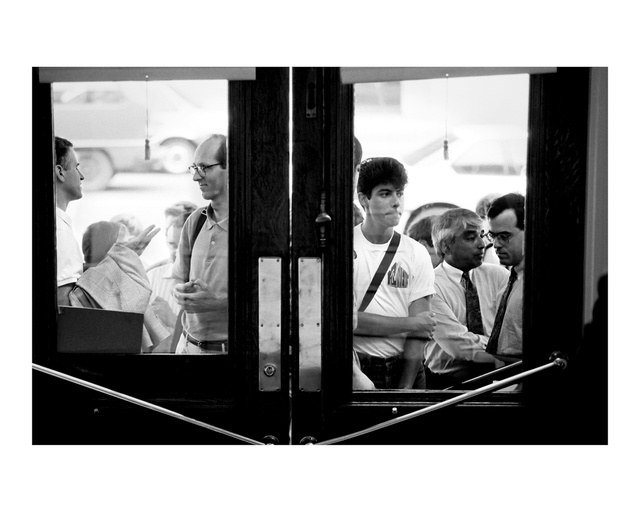
Waiting For Steve. Davies Symphony Hall, San Francisco, California, 1988. Fans and journalists wait hours to enter Davies Symphony Hall in San Francisco for the introduction of the NeXT Computer. Steve Jobs took the stage for a marathon three-hour session demonstrating the powerful new computer for education. The general response was tremendously positive, with dozens of magazines featuring Steve on their covers, heralding his comeback. But his core customer base in education was enraged at the $10,000 price tag after being promised an affordable computer.
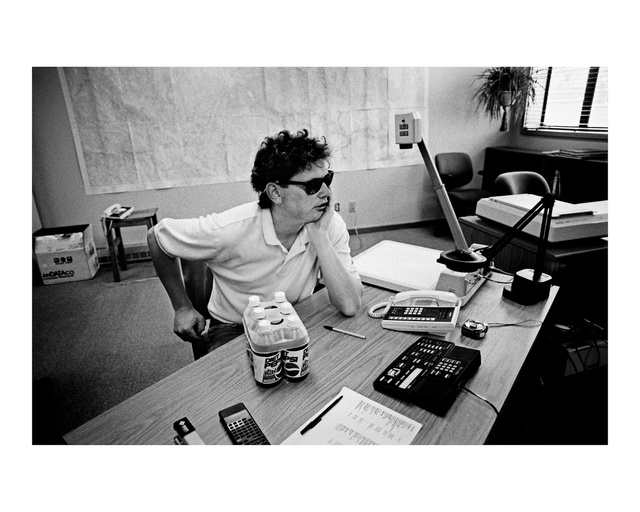
Bill Joy is Worried About the Future of the Human Race. Aspen, Colorado, 1998. Legendary programmer, industry leader and co-founder of Sun Microsystems, Bill Joy now believes unfettered innovation for its own sake endangers the very existence of the human race. In 2000, Bill published a manifesto in WIRED Magazine that stunned the technology world by challenging the accepted value of unrestrained innovation. He warned that the convergence of our most powerful 21st Century technologies––robotics, super computers, nano technology and genetic engineering––will destroy the human race without thoughtful controls on development. While a student at UC Berkeley he wrote Berkeley Unix, then helped the US Defense Department with the TCP/IP stack code that allowed email to travel along the path of least resistance in case of nuclear attack, completing the code over a weekend. He then co- founded Sun Microsystems, became a billionaire, husband and father, and patron of the arts. He also championed and helped finish the code for Java. He’s shown here in Aspen where he moved his office to get away from Silicon Valley. Today, he’s back in the Valley as a venture capitalist investing in alternative energy sources at Kleiner Perkins.
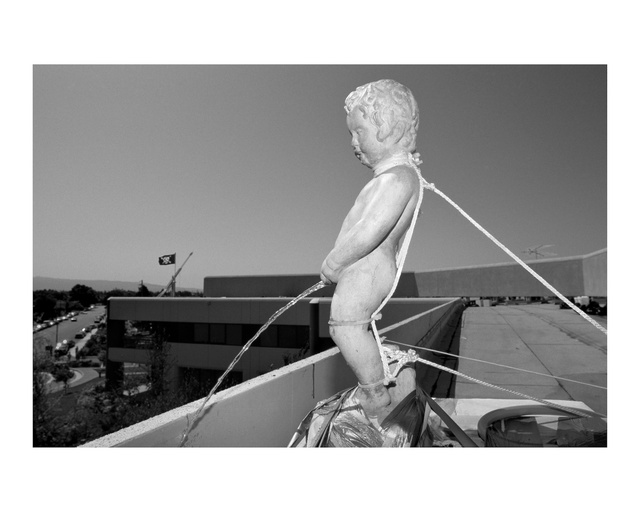
Manneken Pis Overlooking a Campus Water Fight at Sun Microsystems. Santa Clara, California, 1995. With the famous Manneken Pis boy endlessly urinating on the roof, down below over a thousand Sun Microsystems employees are having an elaborate water fight. Staged across the corporate campus, it was led by their CEO Scott McNealy and senior management equipped with elaborate water weapons. With its innovative workstation, Sun was the fastest growing technology company between 1985-89.
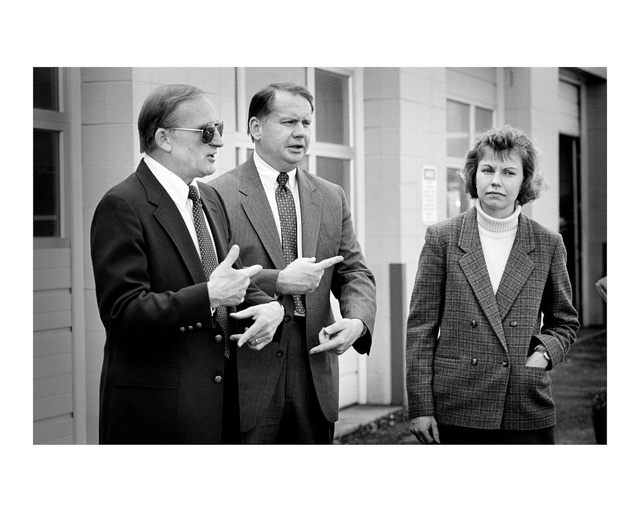
Selling. Maryland, 1991. DuPont sales and marketing executives finish each other’s sentences during a marathon day of sales pitches to auto paint shops promoting a new paint recycling technology. DuPont figured out there was money to be made in protecting the environment from the very chemicals it manufactured.
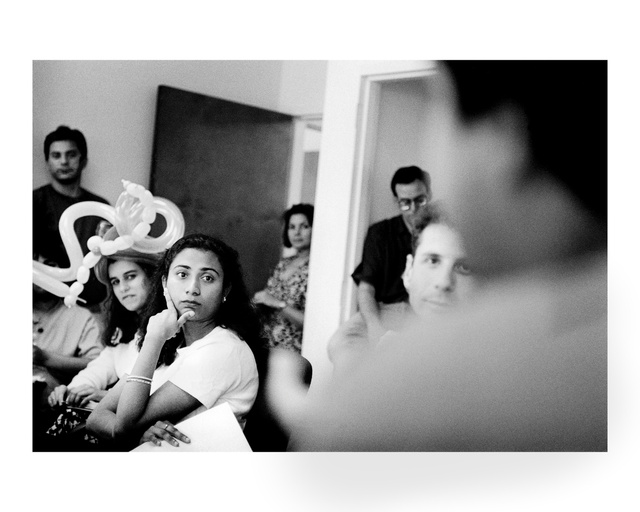
New Employees Are Requested to Wear Balloon Hats. Redwood City, California, 1998. Samir Arora, Founder and CEO of NetObjects (at right in soft focus) is pushing his team in their attempt to “own” the web page design software space during a staff meeting at company headquarters. New employees were asked to wear balloon hats as a mild hazing ritual. This was believed to improve bonding of team members, so crucial in high-pressure work environments, or battlefields.
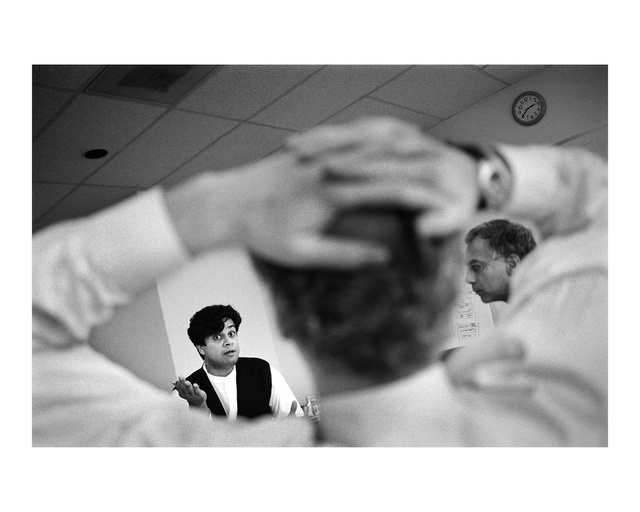
Samir Arora Facing Down His Investors. Redwood City, California, 1999. Samir Arora refuses his venture capitalist partners as they ask him to resign. An enduring archetype of Silicon Valley has the innovator and founder pushed aside for lack of management skills or conflicting strategic goals. Almost every company goes through this, including Apple with Steve Jobs. Shockingly, Samir broke the tradition, refusing to relinquish his vision. The investors were furious and cut off his funding, forcing Samir to tell 125 employees on a Friday afternoon that after four brutal years of blood, sweat, and tears they were all fired. Samir went home and began calling every investor he knew and by noon Monday he had ten million dollars in the bank. NetObjects was saved. A short time later he engineered a sale of the company to IBM, netting his investors a 10,000 percent return in three months. The success was tempered in March, 1999, when NetObjects became the first company in the history of the internet with an IPO to close lower than their opening price. CNN asked, “Is this the beginning of the end of the dot-com bubble?” It was.
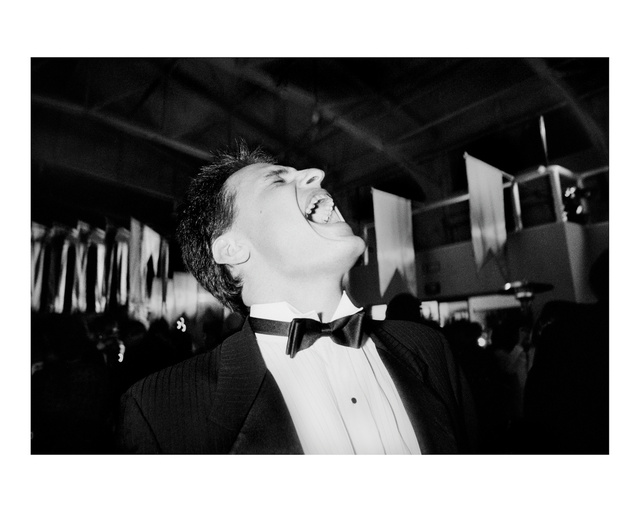
Howl. San Francisco, California, 1988. An Adobe Systems employee howls with joyful release during a toast to their spectacular year. Their year-end party was staged in a massive pier in San Francisco and reportedly cost a million dollars. As Silicon Valley growth and success became exponential through the 1980s, holiday parties rivaled Las Vegas stage productions.
